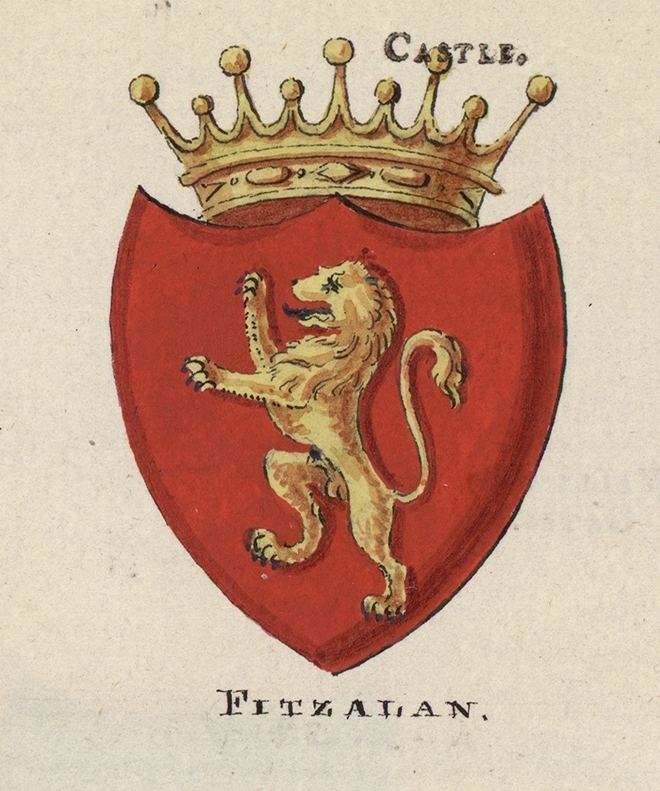Region of origin England | ||
 | ||
Related names | ||
FitzAlan is an English surname ultimately of Norman origin. The family shared common ancestry with the Scots royal Stewarts. They were descendants of the Breton knight Alan fitz Flaad (d. 1120), grandson of the Seneschal of the Bishop of Dol. The FitzAlans held the earldom of Arundel during the period 1267 - 1580.
Contents
Variants include Fitz-Alan, Fitzalan, Fitzallen, Fitz Alan, as well as the locational variants Arundel and Arundell because of the earldom.
Family members
People with the surname FitzAlan include:
Henry Fitzalan-Howard, 14th Duke of Norfolk (1815–1860), the 13th Earl of Arundel of the Fourth Creation (1580) revived use of the Fitzalan surname, in the hyphenated form "Fitzalan-Howard". Edmund FitzAlan-Howard (1855–1947), son of the 14th Duke of Norfolk, in addition was raised to the Peerage as "Viscount FitzAlan of Derwent" in 1921 when he was appointed Lord Lieutenant of Ireland. Lady Marcia Fitzalan-Howard (b. 1953), daughter of the 17th Duke of Norfolk, uses the stage name Marsha Fitzalan as an actress.
The controversy over Stewart ancestry
Alan's role was formerly obscure because of the political implications of examining the origins of the Stewart dynasty. Holinshed, deriving his information from the work of Hector Boece, asserted that Banquo, Thane of Lochaber, was the ancestor of the Stewarts. Distorting the role of Banquo, who is presented by Holinshed as Macbeth's chief accomplice in regicide, William Shakespeare presented him flatteringly in Macbeth as a martyred ancestor of James VI of Scotland and I of England. These legends, accepted as history, became part of the foundation narrative of the Stewarts and forced later writers to trace the Stewart ancestry through Fleance, Banquo's son. David Symson, the Historiographer Royal of Scotland, in a work dedicated to Queen Anne, followed the chroniclers in having Fleance marry a daughter of the Welsh ruler Gruffydd ap Llywelyn, and then introduced Walter as his son and Alan fitz Walter, 2nd High Steward of Scotland as his grandson. However, this greatly distorted the chronology, forcing Sym to transpose Alan fitz Walter, actually born around 1140, to about 1073. This created a gap in the record, which was filled by multiplying the Alans and Walters in the Stewart line.
David Dalrymple, Lord Hailes, in his Annals of Scotland, published in the 1770s, went some way to establish a convincing chronology for Walter fitz Alan, who, he asserted, belonged to the reign of David I of Scotland (1124-53) and his successor, Malcolm IV. Moreover, he was the first of the Stewarts: there was none in the reign of Malcolm III (1058–93), as Symson had been forced to maintain. He went on to demolish the legendary background to the Stewarts, which he described as "flattering and ignorant fictions". He showed that there was a need to distinguish the various Alans who were connected with the Stewart line, something he was unembarrassed to be unable to do:
Some of my readers may demand, "Who then was Alan the father of Walter, Stewart of Scotland in the reign of Malcolm IV?" ... In the reign of David I, before the middle of the twelfth century, the family of the Stewarts was opulent and powerful. It may, therefore, have subsisted for many ages previous to that time; but when, and what was its commencement, we cannot determine.
Andrew Stuart, a notable Scottish MP, accepted Dalrymple's critical work on the legendary ancestors, although he included among these a crusader Alan who was subsequently to emerge as genuine. He sought to establish a definite chronological framework, placing Walter fitz Alan's death in 1177.
Not until the first decade of the 19th century did George Chalmers definitely prove that Walter fitz Alan, an acknowledged link in the Stewart ancestry, came from Shropshire and was actually the son of Alan fitz Flaad. This finally established Alan fitz Flaad's existence and importance, and confirmed the kinship between the Stewarts and the FitzAlan Earls of Arundel. Even then, the legendary background took almost a century to fade. In 1858, Robert William Eyton, the distinguished historian of Shropshire, while clarifying Alan fitz Flaad's connection with the county and details of his marriage, still tried to maintain a link with the legendary Banquo, and even surmised that Flaad was actually Fleance.
After an anonymous work of 1874 drew attention to a strong connection between Alan fitz Flaad and Brittany, and confirmed Flaad's relationship to Alan the Seneschal, J. Horace Round definitively established and publicised Alan fitz Flaad's true Breton origins in 1901 in a collection of genealogical essays. Alan's father, Flaad (rendered in numerous way, including Flaald and Flathald), was a son (or possibly a brother) of Alain, dapifer to the Ancient Diocese of Dol, with its see at Dol-de-Bretagne, who had taken part in the First Crusade in 1097. "Alan Dapifer" is found as a witness in 1086 to a charter relating to Mezuoit, a cell near Dol of the Abbey of Saint-Florent de Saumur. The area of Dol is near Mont-Saint-Michel and has figured in the history of the Duchy of Brittany since at least the rule of Nominoe. Round's genealogy was confirmed in 1904 by Sir James Balfour Paul, then Lord Lyon King of Arms, who, in a definitive work, The Scots Peerage, stated that "the Stewarts or Stuarts are of Breton origin, descended from a family which held the office of Senescal or Steward of Dol." He then reinstated Alan fitz Flaad to his place in the ancestry of the Scottish royal family and gave a summary of what was known of his career.
Alan fitz Flaad: family tree
Round provided a family tree to embody his essential findings, which is adapted below.
Armorial
See also: Category:FitzAlan arms
